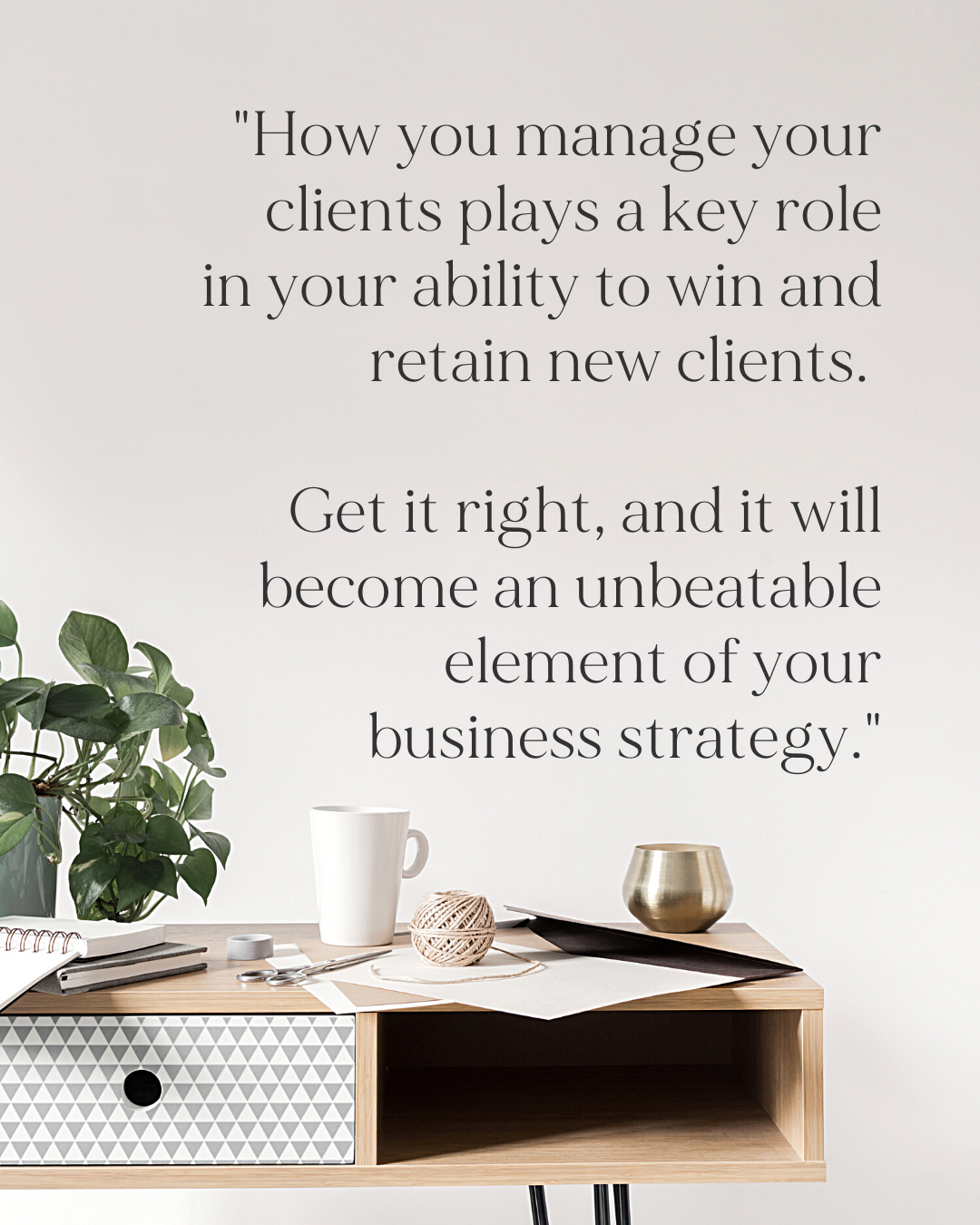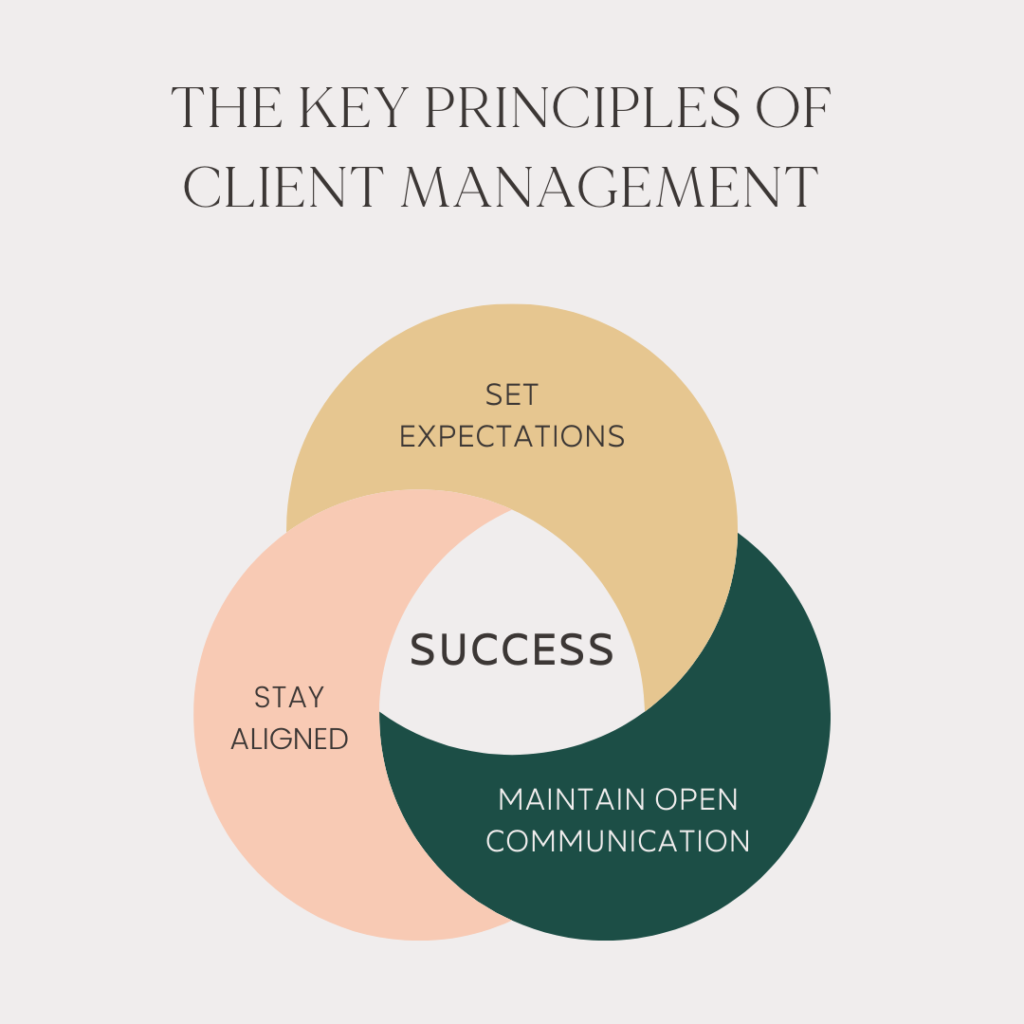

Client management 2022 & beyond | How to win & retain clients


A lot (to put it lightly!) has changed in the past two years – not least our approach to client management. As more and more businesses move online due to the pandemic, the need to adapt your client management to slot seamlessly into the digital world has become pretty paramount. Whether that’s adjusting your technology, realigning your systems or analysing how well looked after your clients actually are, now is the time to put the steps into place for a fruitful 2022.
Client Management is the method of managing the relationship you have with your clients. It covers everything you do and ask of your client to ensure that their experience aligns with your brand values and builds loyalty.
Client management is a fundamental part of crafting an incredible, tell-all-your-friends-about-it customer experience. How you manage your clients plays a key role in your ability to win and retain new clients. Get it right, and it will become an unbeatable element of your business strategy.
But, just how do you ‘get it right’?
RELATED: WORK WITH ME IN 2022.
What Is Client Management?
The great news is that client management really isn’t complicated. It’s simply about anticipating your client’s needs and delivering on them in a way that works for both of you.
Sounds easy enough, right? You can pull together this information in subtle and undemanding ways. The first is adding it into your market research. Use your platforms – be that social media, your email list… Whatever floats your boat – to pinpoint precisely what is keeping your clients up at night. Ask the questions and listen to the answers. Follow and engage with them – what is their preferred means of communication? What little touches mean a lot to them? What do they value, both personally and professionally?
In addition, check in on your ideal client profile. Do you have one? If the answer is anything other than ‘I LIVE by it Steph!’, then it’s time to get on it. Who are your clients? How do they digest information? What does a typical day look like for them?
If you can gather all of these insights, you can layer them into a truly special client experience. Keep these nuggets of information at the forefront of your mind as you move through to the next step.
The Key Principles of Client Management
There are key principles that you need to cover when it comes to client management; follow these, and you will find yourself the owner of a robust and impactful client management process.
These principles should be seen as the foundation of your client management strategy: a layer which you can then build upon, brick by brick, until you have something ‘wow’ worthy.


It starts with open communication. You need to be honest, transparent, responsive and proactive. No, this doesn’t mean airing your dirty laundry or telling them that their last email resulted in a major case of tears over your coffee. It’s about ensuring they are always in the loop; even when this loop causes a bit of discomfort. For example, if you’re running late on a deadline, tell them! It’s MUCH worse ghosting your client and hoping that they won’t notice. Remember, they will also be working on their own work which may well be resting on your final piece of the puzzle. As long as they are aware of any changes on your end so that they have everything they need to make their own informed decisions, they will trust you. And when it comes to client relationships, trust is everything.
Next, be sure to set expectations from the very first interaction. This could be to do with anything. Invoice payments, response times, means of communication… Lay it all out from the word ‘go’ and avoid any tricky, awkward future conversations. This will save you both time and energy and ensure that you can keep delivering a brilliant service.
The final pillar ties together the previous two – stay aligned. By this, I mean always confirm any changes to deliverables and timelines and then set out next steps and who is accountable for them. Make sure everyone is on the same page, always. You can do this through shared workspaces, project management boards or even good old email.
How to retain clients
Client retention is key to a sustainable business. You can maximise your ability to keep those long standing clients on side through a stellar client experience.
It’s your secret weapon – your means of standing out from your competitors. Clients should ENJOY working with you. It should feel light and inspiring. If your client experience is falling by the wayside, how can you realistically expect to make that a reality?
Facts are facts: how your clients feel when they work with you will determine whether they stay or not. In fact, a PWC survey found that 1 in 3 clients will leave a brand they love after just one bad experience. That’s scary, right? All it could take is one mistake to lose an absolute dream client.
And it doesn’t matter if you’re the best of the best at what you do. The accolades, the bylines, the social media followers… They mean nothing if your client experience doesn’t match up. This is no exaggeration. You could be an award-winning brand photographer, interior designer, copywriter, brand strategist or web designer. Your deliverables could be out of this world. But (and it’s a big but), if your clients have to chase you for replies, keep receiving the wrong invoices, have no idea of project progress or feel like they’re at the bottom of your list… Well, why would they stick around? The quality of your work isn’t enough to keep them. It needs to be one part of an expansive client experience.
Plus, a well designed service suite will give your clients somewhere to go when one service is completed. If they’ve done an intensive, do they need ongoing accountability? If they’ve done a course, do they need coworking, a membership or a 1:1? If they’ve done a power hour, do they need an intensive? Each service must hold value in it’s own right; it shouldn’t rest on the assumption that they will move straight onto another package. That doesn’t mean that you can’t create a range of paths ready for your clients to peruse if (and when!) they want more.
How to win clients
While it’s vital that you strive to retain as many clients as possible, you also want to welcome new ones in. There are countless ways to do this: something which is both exciting and overwhelming.
If you aren’t sure where to start, don’t worry – you aren’t alone! This is why I adopt a ‘one thing a day’ approach to business development. Every day, I do (at least) one thing that will help send my business out into the world. And this ‘thing’ can be tiny. It could be updating a package on your website. Or getting in touch with a past client. A social media post.
What I like to do (and something I encourage my clients to do) is to have a list of these different techniques up in clear sight in my office. That way, I can simply glance up at it and decide what I have the capacity for. Do this consistently and I promise you, you will see a huge difference in your pipeline.
Here are a few more ideas for you to try:
- Follow up with potential clients who didn’t sign up
- Create and share a referral scheme
- Offer free discovery calls
- Join a networking group (I am a huge fan of Found & Flourish)
- Collaborate with a past client or business buddy on IGLive or a webinar
RELATED: 10 TIPS FOR ORGANIC BUSINESS GROWTH
Danielle Garber of the brand consultancy Be More You has shared 30 proven ways to get new clients.
Client management tools
If communication, managing expectations and alignment are the key principles of client management, then process, tools and tech are the backbone. You should therefore dedicate sufficient time to making sure you’ve got the right client management tools for the job.
So, where do you start? Take a deep dive into your client experience and map out the MANY ways that you can pre-empt and meet (*cough* or surpass) your client’s needs. Throughout this process, keep your own values and strategy right there at the core. They should drive every decision and influence the path that you eventually take. Why? Because this will guarantee that every encounter *feels* like your business, and every tool or piece of tech will be fit for the future and whatever you have planned for your business.
This matters. A business that is practically bursting with its own unique identity will have far higher brand equity than one which barely gives these things the time of day. Higher brand equity = more loyal customers = a higher price tag. Win win.
RELATED: HOW SHOULD I CHARGE MY SERVICES?
A few areas to consider for your client management tools and tech include:
Onboarding
It’s no secret that onboarding can be admin intensive. Enquiry calls, proposals, contracts, invoices and questionnaires all take time and energy. Plot out exactly what you and the client needs. Set expectations, explain how to communicate during the project, and remind them of timelines. You can communicate this through a set of standard emails and templates, all rich in your brand tone of voice. That way, you’re consistently delivering a good experience and they are armed with the information they need, before they know they need it (and without taking up even more hours of your time)!
Service delivery
There’s no way around it – you must deliver everything you advertise. If you say you’re going to share a preparatory document, create a Pinterest board, have a monthly catch up call or create an action plan, then you need to do it. So again, map out your services as a process, identifying your touchpoints, templates and tech requirements. You could even preempt any explanations needed by recording explainer videos or creating quick reference guides. The aim here is to make your clients feel supported and like you’re always there, even when you’re not.
Your email
Before you do ANYTHING else, put on an auto response that reiterates your communication guidelines. If you don’t work Fridays, tell them. If you only check emails twice a day, then say it. If you don’t actually communicate with current clients through email, then direct them to the right place. This will continue to set expectations with your clients every time they email you.
And respond in the time you say you’re going to respond. It’s just better for everyone! If you haven’t got the information the clients want, or the project hasn’t progressed as you’d hoped, be honest. Thank them for their patience, and let them know what the next steps are. It doesn’t have to be a big song and dance. Small and steady communication will always be to your advantage.
Gathering feedback
Feedback is crucial to the ongoing success of client management. Only your clients truly know how it feels to work with you, so let them share valuable information on what works and what could be improved. Sure, this can make you feel quite vulnerable, but it really is the best way to learn and improve.
Client management software
The super exciting thing about client management software (and yes, you know I’m a tech geek!) is that, these days, most of it can be automated. Cue more time, more headspace and a hefty boost in your client experience.
Handling enquiries, onboarding and offboarding are processes that are just screaming out for a bit of the ‘A word’. CRMs like Dubsado, Paperbell, HubSpot, Kitchen and Zoho are epic at handling client admin. They’ll take care of your standard emails, forms, invoices, contracts… ALL OF IT! See. I told you it was exciting.
You can then use a central project or service management tool like ClickUp, Asana, Trello or Notion to keep everything in one clean space. This will be a game changer for you and your client. You can both see, at a glance, where the project is at. Email traffic will reduce (hurrah!). And the best bit? You can create template boards so you’re not reinventing the wheel with every client. That means you won’t forget anything!
When you bring this all together, it will feel super slick to your client, and take you less time. And there are so many software solutions out there, so you can absolutely find one that makes sense for you. It’s worth taking your time to understand what you need both now and for the long term. Tech implementations aren’t something you want to do too often! So research well, and commit to the set up. Your clients, and business, will thank you for it.


Steph Sanderson is a business design consultant who helps service-based businesses to accelerate their growth in a sustainable way through pricing, customer experience, process planning, systems and strategic planning. She has over 15 years experience in the field, working as a business manager, global Change Manager and Implementation Specialist. Find out more.
